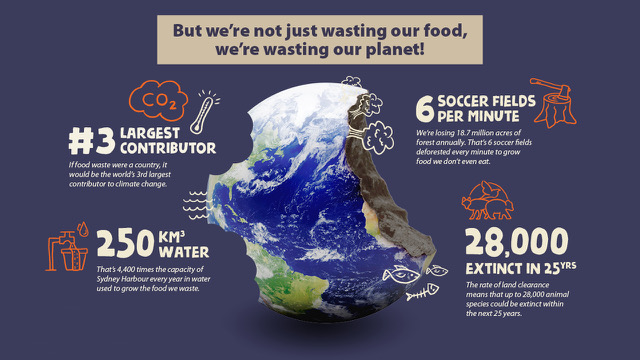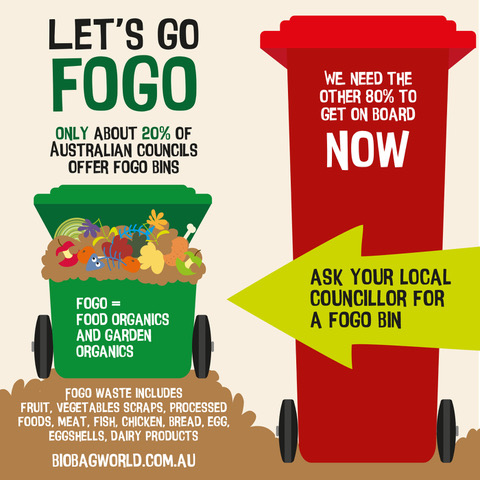By Chelsea McLean
Organics is the principal component of residential waste sent to landfill in Australia and about half of our country’s food waste comes from our homes. Globally, one third of all food produced for human consumption is lost or wasted, that is 1.3 billion tonnes (FAO, 2011). Australia is ranked as the fourth highest food waster in the world on a per capita basis. The economic costs are significant, $20 billion every year (Commonwealth of Australia, 2017).
Global populations are growing, and it is estimated by 2050 we will need to feed 9.1 billion people (FAO, 2009). Today, we produce enough food to feed everyone on our planet and the 2.5 billion more people to come by 2050. However, we must waste less. When we waste food, we are also wasting the earth’s resources. When food waste breaks down in landfill, it emits greenhouse gases including carbon dioxide and methane, a gas 25 times more potent than carbon dioxide. The amount of greenhouse gases produced by food waste in Australian landfills each year is equivalent to the emissions of Australia’s steel and iron ore industries combined (RMIT University, 2018).

There is a significant opportunity to divert organic waste from landfill to compost to return vital nutrients to Australian soil. To enable this, local councils around Australia need to add a third bin for food organics and garden organics (FOGO) waste collection to residential kerbside collection services. Today, around 20 percent of Australian councils offer residents FOGO bins and this number is rising (Australian Government, 2018).
Creating compost from food waste adds vital nutrients back into degraded agricultural soils and recycling valuable resources such as organics creates three times more local jobs than sending waste to landfill (MRA Consulting Group, 2019). Each of us can be part of the solution by asking our local councils for a FOGO bin and recycling our food scraps by composting, using worm farms and sharing food with neighbours in our local communities.

Australians waste an average 298 kilograms of food per capita every year (National Food Waste Baseline, 2019) and a whopping 87 percent of household food waste goes to landfill (National Waste Report, 2018). If food waste was a country, it would be the third biggest emitter of greenhouse gases after the USA and China (FAO, 2013).
Leading Australian food rescue organisation OzHarvest’s founder and CEO Ronni Kahn AO says, “Cutting back on our individual food waste is the single most powerful way we can take direct action against climate change. It’s an easy win, both for your pocket and the planet”.When we waste food, we also waste the natural resources used for growing, processing, packaging, transporting and marketing that food, and greenhouse gas emissions are increased for no value. Organics break down anaerobically in landfill to generate methane, a potent greenhouse gas. The release of this gas to the atmosphere currently contributes close to three percent of Australia’s greenhouse gas emissions (Australian Government, 2018).
Most of the greenhouse gas emissions from landfill come from decomposing organic material which could be recycled. Not only do food and garden organics produce methane as they decompose in landfills, but their nutrients can’t be used again to grow more plants and food if they are locked in landfill.
Of the 21 million tonnes (Mt) that is currently sent to landfill nationally, over 10 Mt is FOGO (Australian Government, 2018). Diverting FOGO from landfill is one of the economical global warming abatement options, according to leading Australian environmental consultant, MRA Consulting Group Managing Director Mike Ritchie. There are major economic benefits from recycling organic waste as landfill levies rise and local councils save in landfill fees. There are also massive environmental improvements in terms of reducing greenhouse gas emissions, improving soil quality and creating almost three times more jobs than landfill. The estimated direct full-time equivalent employment per 10,000 tonnes of waste is 9.2 for recycling and 2.8 for landfill (Access Economics, 2009).
Melbourne and Adelaide were early adopters of FOGO and the Western Australian Government recently announced a requirement for three bin systems in metro Perth. Many regional areas in New South Wales have FOGO bins but Sydney and Queensland each only have one council with FOGO services. Queensland’s increased landfill levy may encourage councils to reassess FOGO collections for households.
FOGO services are the most efficient way to recover organics from the municipal waste stream and FOGO needs to become the standard waste service for all Australian households because organics belong in our soils, not in landfill. However, composting organics and returning it to farmers is currently uneconomical for many councils and businesses that create food waste. The solution is either to subsidise organics collections and the construction and operation of composting facilities, or to ban organics to landfill, according to MRA Consulting’s Mr Ritchie.
In the meantime, everybody can use compost piles, compost bins, worm farms and bokashi bins to keep food scraps out of landfill. The ShareWaste app connects people who want to recycle their kitchen scraps with their neighbours who are already composting, worm-farming or keep chickens.
An estimated 33 percent of the world’s soil is moderately to highly degraded due to erosion, salinisation, compaction, acidification, and chemical pollution (FAO, 2015). The FAO of the United Nations brought together the work of some 200 soil scientists from 60 countries and concluded: “Further loss of productive soils would severely damage food production and food security, amplify food-price volatility, and potentially plunge millions of people into hunger and poverty. But… this loss of soil resources and functions can be avoided“.
Food waste converted to compost is a solution to this problem. The highest value for organic matter is to be recycled into compost to recover degraded soils and restore fertility and carbon sequestration in the soil. Compost can improve soil’s resilience to shocks such as drought, including climate change adaptation. It can increase moisture retention, regulate soil temperature, reduce water evaporation and reduce erosion. Further, it can reduce the use of chemical inputs such as fertilisers and pesticides, resulting in lower production costs for farmers and negative environmental impacts (Applied Soil Ecology, 2018).
Australian Organics Recycling Association Chair Peter Wadewitz has been commercially processing compost for over forty years and says sustainable agriculture needs two to four percent carbon in soil, but there’s only 0.5 to one percent carbon in some Australian farming areas. “The composting process makes carbon stay a long time in the soil,” Mr. Wadewitz said. “Some of the compost we are producing now will last 25, 50, 100 years in soil.”Soil health is critical for food security and nutrition and soil is a finite resource. Loss of soil and degradation of soil cannot be recovered within a human lifespan. In fact, it can take up to 1,000 years to create one centimetre of fertile soil. Sustainable soil management could produce up to 58 percent more food (FAO, 2015).

We need to keep food waste out of landfill, and we need to do this urgently to fight climate change. Composting inedible food waste represents an opportunity to significantly reduce greenhouse gas emissions while improving soil quality. The processes and technology needed to capture food waste and transform into soil fertiliser are already being used around Australia. This must become best practice across the country. In the meantime, each one of us can help to reduce the amount of food we waste in our own homes. We can ask the Federal Government to ban sending food waste to landfill, like South Korea did in 2005. We can ask our State Governments to increase landfill levies to encourage more food waste recovery. In addition, you can ask our local councils to provide FOGO bins to collect food waste from our homes and businesses.
References
- Food and Agriculture Organization of the United Nations. (2011). ‘Global Food Losses and Food Waste’. https://www.unenvironment.org/regions/north-america/regional-initiatives/minimizing-food-waste
- Commonwealth of Australia. (2017). ’National Food Waste Strategy: Halving Australia’s food waste by 2030’. http://www.environment.gov.au/system/files/resources/4683826b-5d9f-4e65-9344-a900060915b1/files/national-food-waste-strategy.pdf
- Food and Agriculture Organization of the United Nations. (2009). ‘How to Feed the World In 2050’. http://www.fao.org/fileadmin/templates/wsfs/docs/expert_paper/How_to_Feed_the_World_in_2050.pdf
- RMIT University, ‘Watch My Waste’. (2018). https://watchmywaste.com.au/food-waste-greenhouse-gas-calculator/
- Rabobank (2018). Savings [Image]. https://www.rabobank.com.au/savings/2019/03/26/05/27/financial-health-barometer-food-waste-infographic-2018/
- Australian Government. (2018). ’National Waste Report 2018’. https://www.environment.gov.au/system/files/resources/7381c1de-31d0-429b-912c-91a6dbc83af7/files/national-waste-report-2018.pdf
- MRA Consulting Group. (2019). ‘Growing Regional Jobs Through Recycling’. https://blog.mraconsulting.com.au/2019/09/20/growing-regional-jobs-through-recycling/
- Arcadis. (2019). ’National Food Waste Baseline’. http://www.environment.gov.au/system/files/pages/25e36a8c-3a9c-487c-a9cb-66ec15ba61d0/files/national-food-waste-baseline-executive-summary.pdf
- Food and Agriculture Organization of the United Nations. (2013). ‘Food Wastage Footprint – Impacts on Natural Resources’. http://www.fao.org/3/i3347e/i3347e.pdf
- Australian Government. (2018). ’Australia’s Emissions Projections 2018’. http://www.environment.gov.au/system/files/resources/128ae060-ac07-4874-857e-dced2ca22347/files/australias-emissions-projections-2018.pdf
- Access Economics. (2009). ‘Employment in Waste Management and Recycling’. https://www.environment.gov.au/system/files/resources/5cc6a848-a93e-4b3f-abf7-fc8891d21405/files/waste-and-recycling-employment.pdf
- Food and Agriculture Organization of the United Nations. (2015). ‘The Status of The World’s Soil Resources’. http://www.fao.org/3/i5199e/I5199E.pdf
- Applied Soil Ecology, Maria Pergola-Alessandro Persiani-Assunta Palese-Vincenzo Meo-Vittoria Pastore-Carmine D’Adamo-Giuseppe Celano. (2018). ‘Composting: The way for a sustainable agriculture’.Food and Agriculture Organization of the United Nations. (2015). ‘Healthy Soils Are the Basis for Healthy Food Production’. http://www.fao.org/assets/infographics/FAO-Infographic-IYS2015-fs2-en.pdf
Resources
- Fight food waste at school: https://www.ozharvest.org/fightfoodwaste/resources/#sc_s3
- ShareWaste: https://sharewaste.com/
- United Nations (SDG 2): https://www.un.org/sustainabledevelopment/hunger/
- End Food Waste: www.endfoodwaste.org Oz Harvest: https://www.ozharvest.org/fightfoodwaste/



